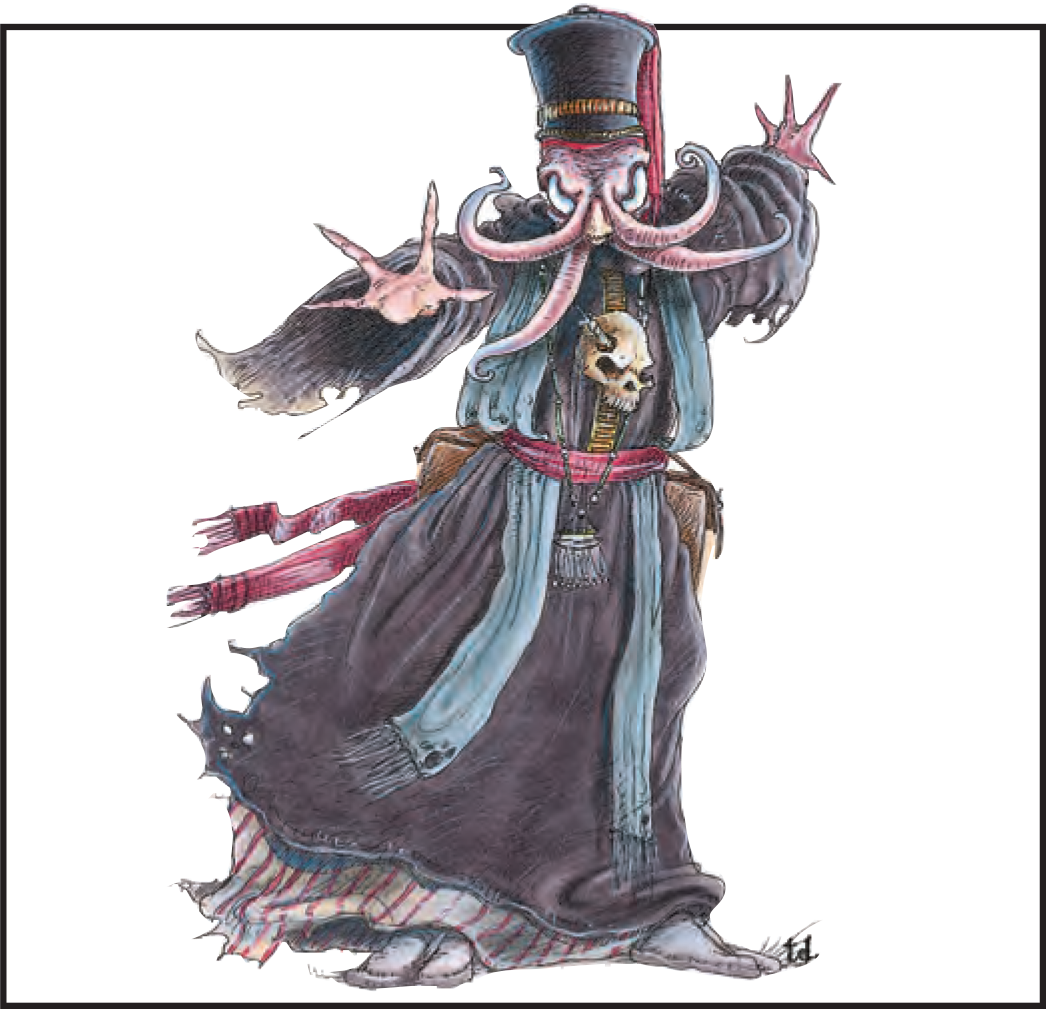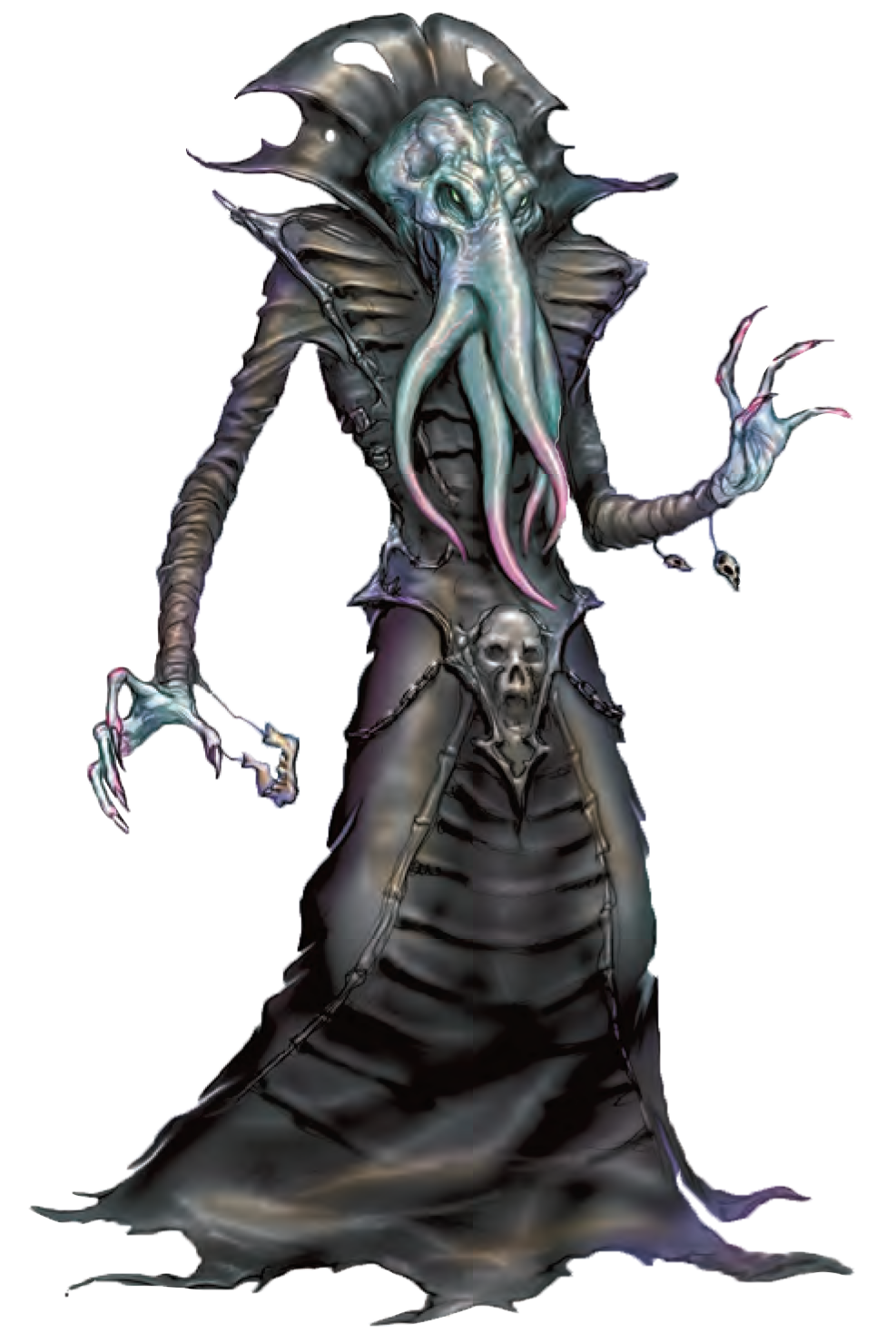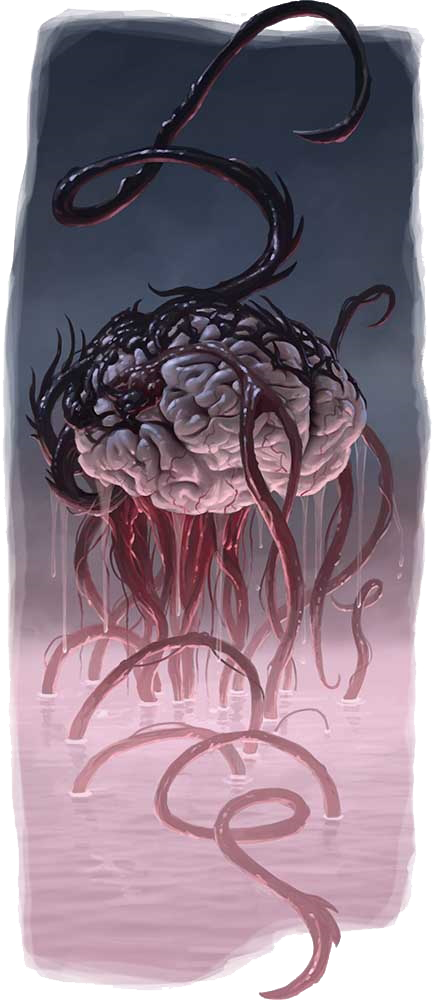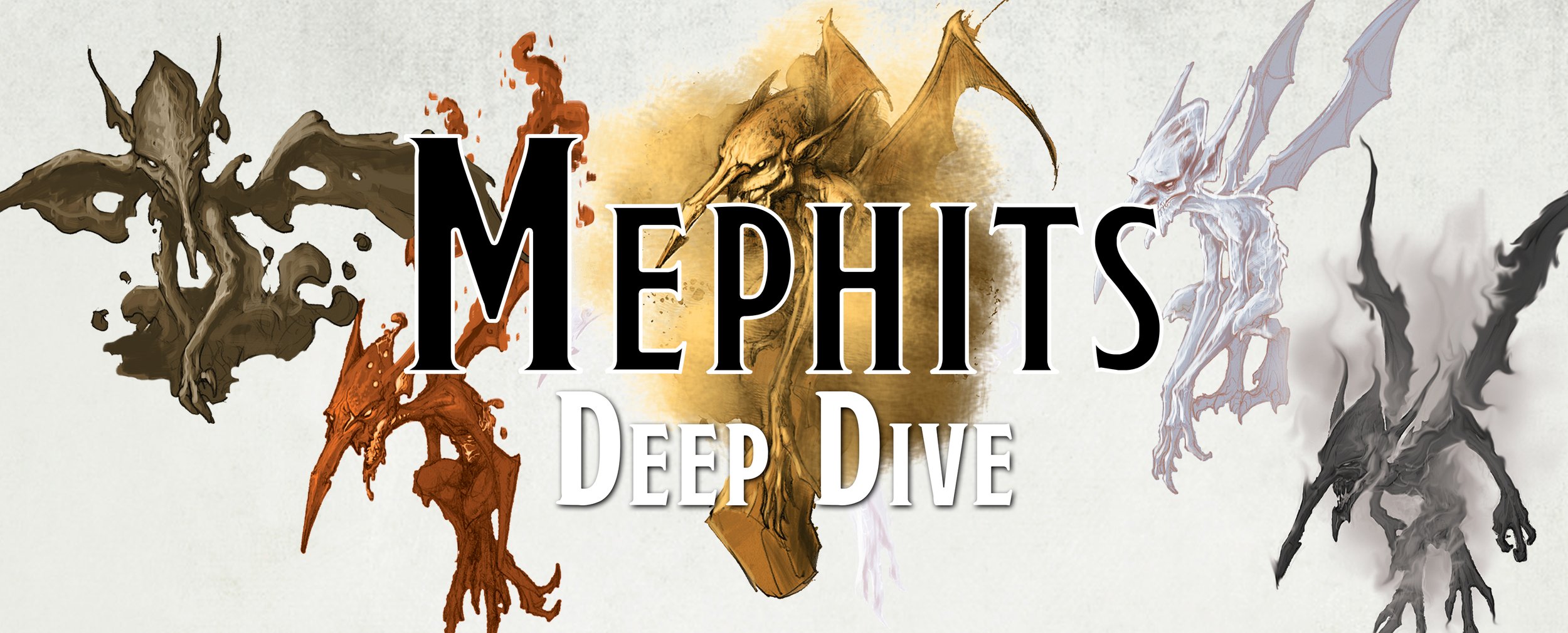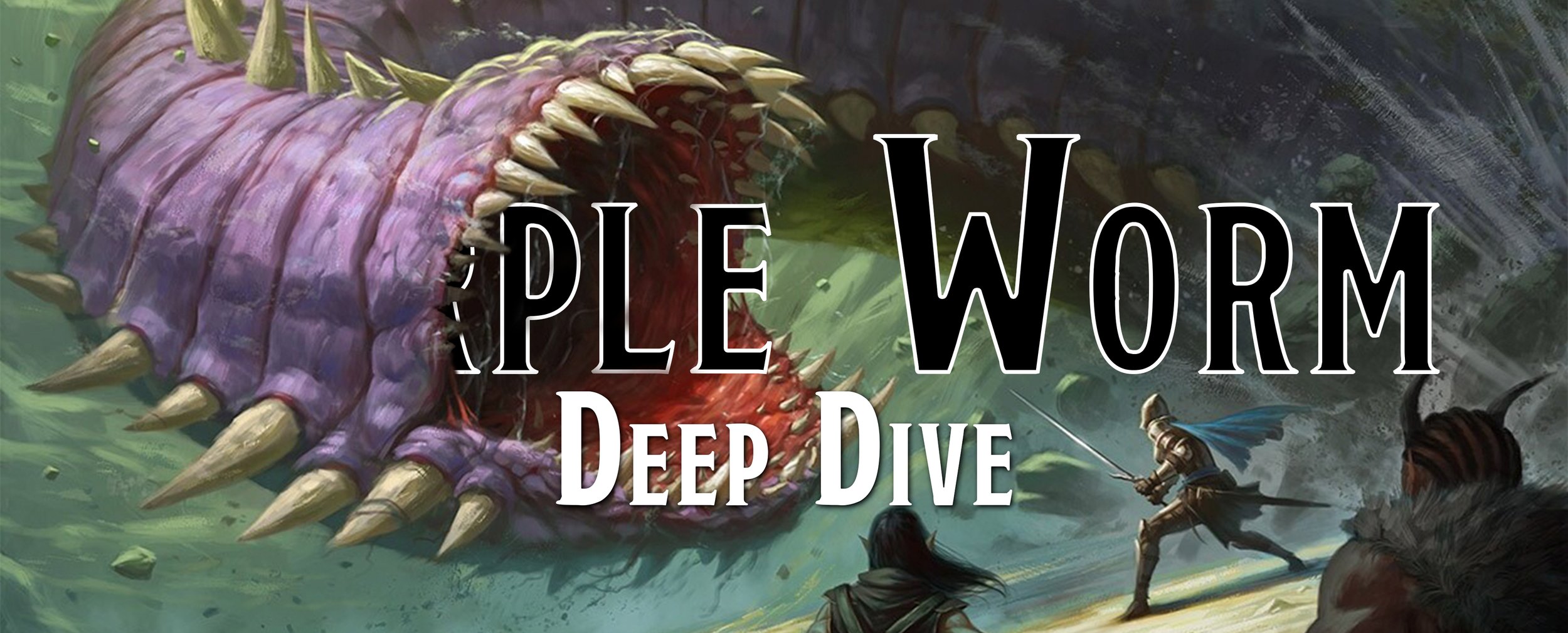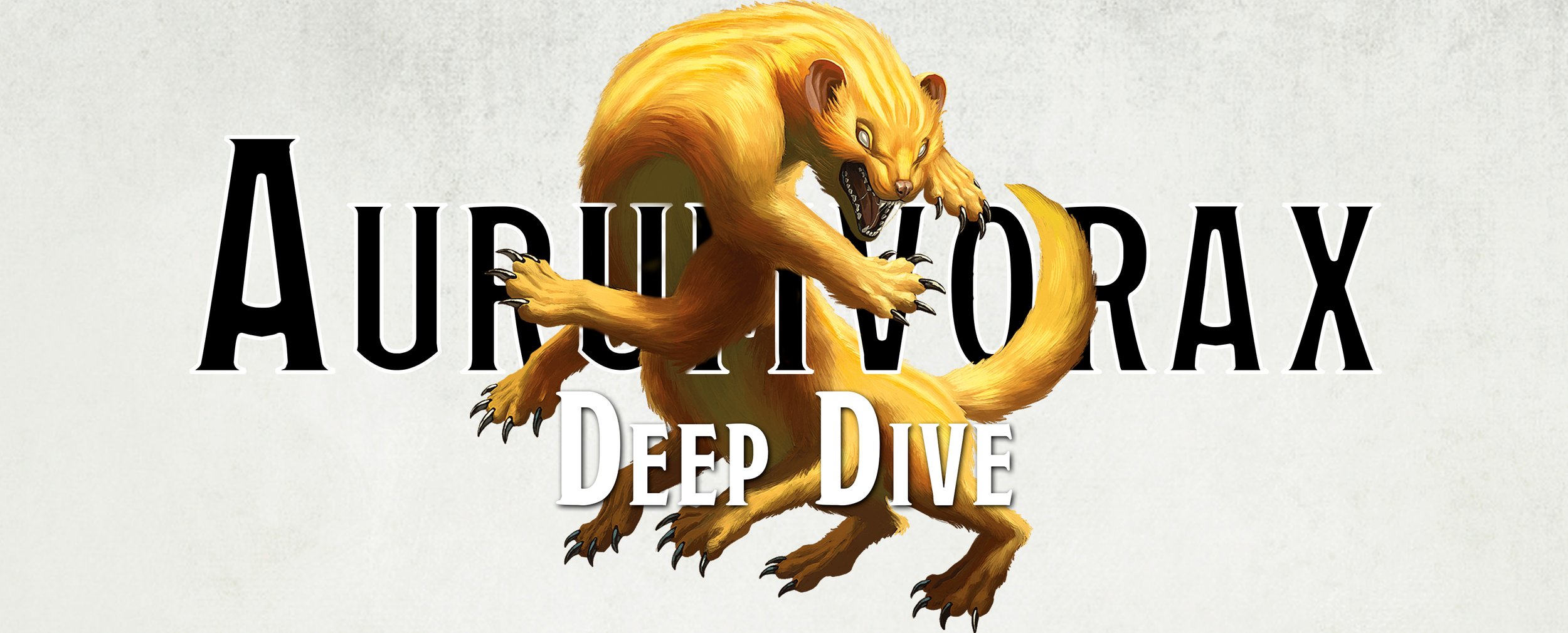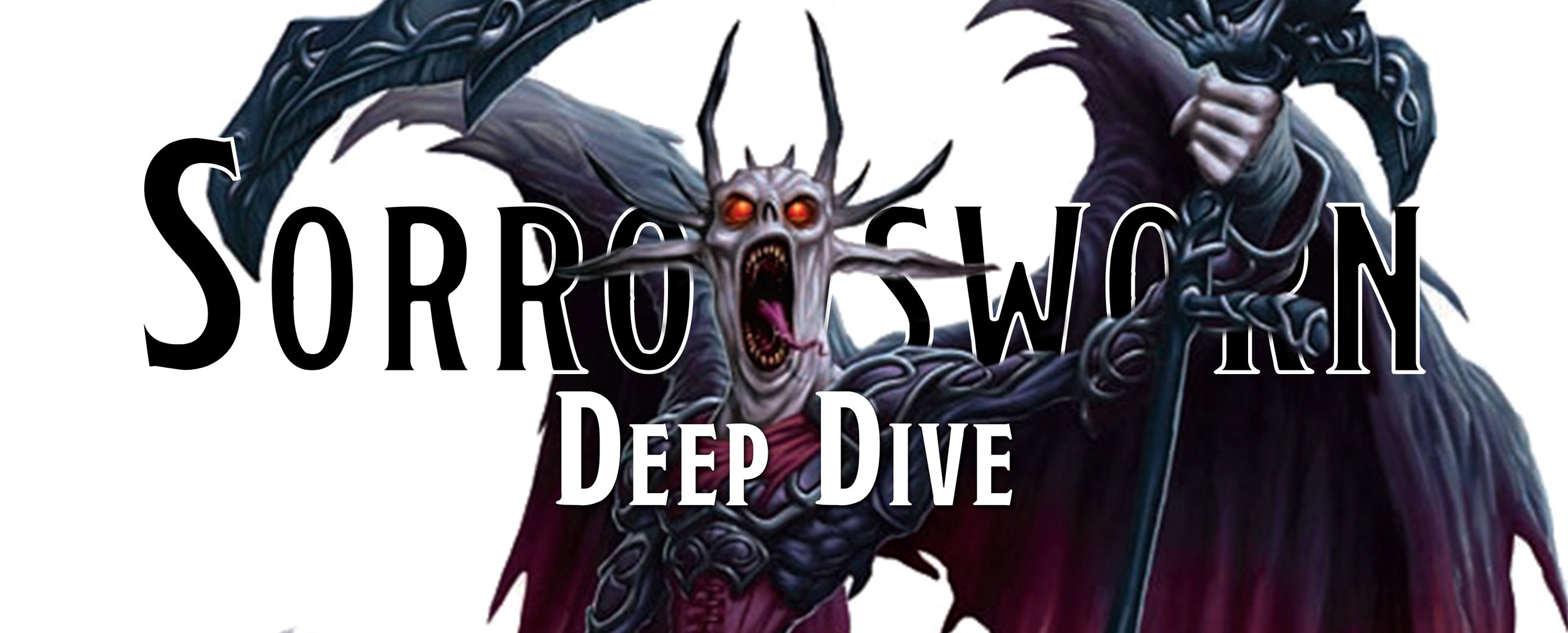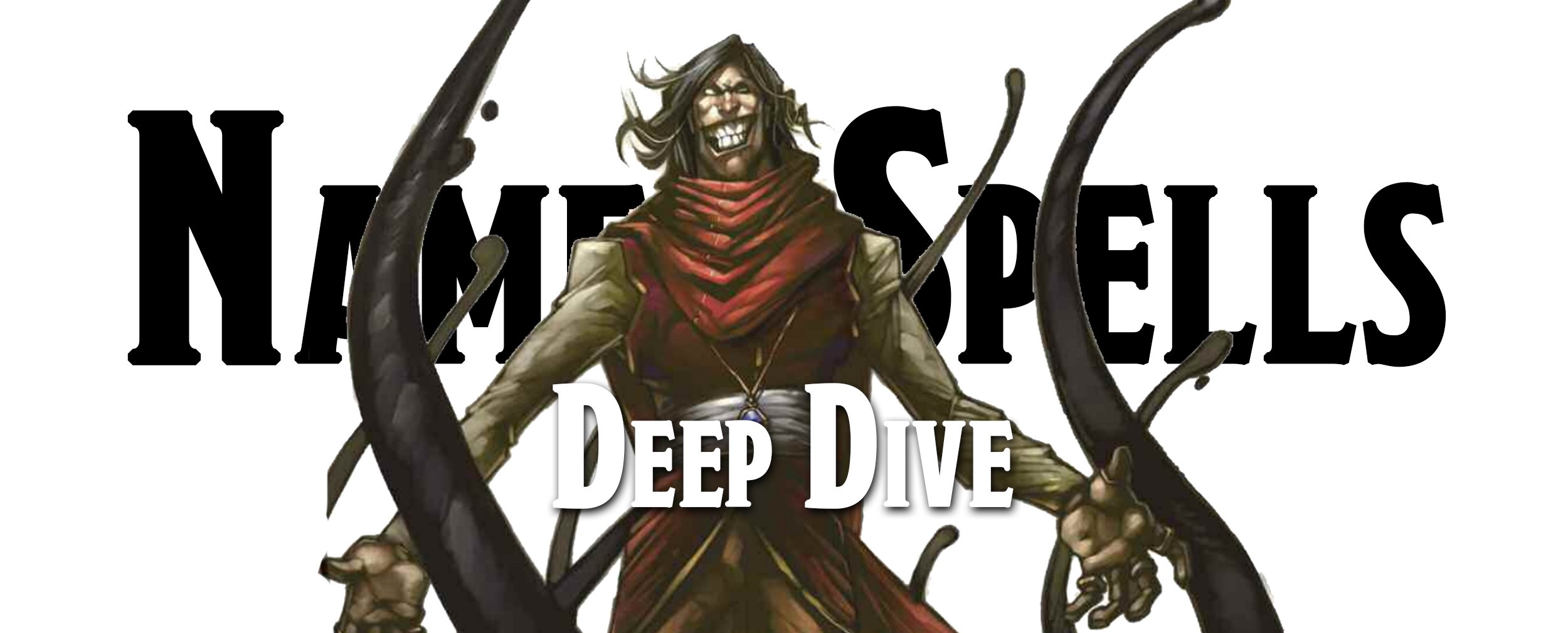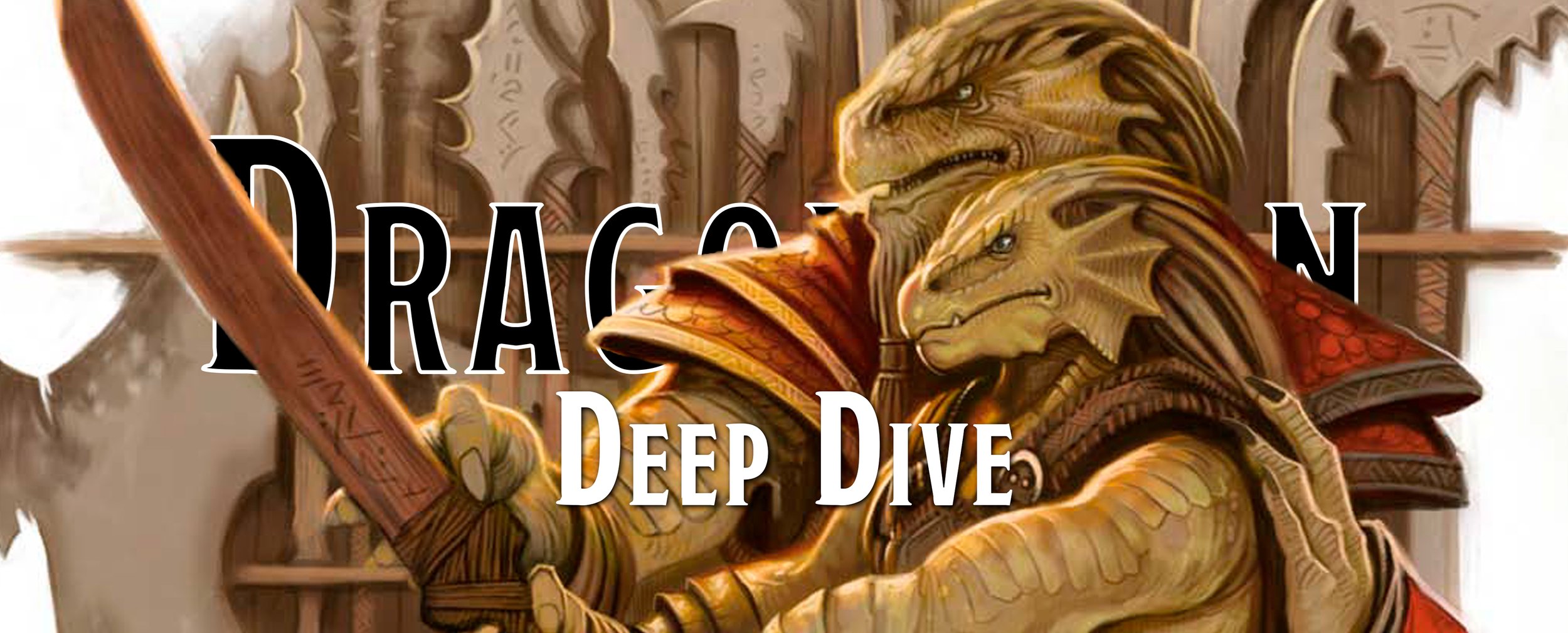Deep Dive - The Mind Flayer
The Mind Flayer has been around since the beginning of Dungeons & Dragons, and many know the Mind Flayer to be a part of the Illithids, a race of super-intelligent aberrations who believe themselves to be the dominant species of the multiverse. They consume brains, they have tentacles, and they create thralls of lesser species, one would be forgiven if you referred to them as the spawn of the Great Old Ones like Cthulhu. In fact, Gary Gygax created the Mind Flayers and was inspired by the cover artwork for the book The Burrowers Beneath by Brian Lumley. The book series is about fighting against the Great Old Ones and their worshipers, so it makes plenty of sense for why the Mind Flayers resemble those Lovecraftian horrors.
OD&D - Mind Flayer
No. Appearing: 1-4
Armor Class: 5
Move: 12”
Hit Dice: 8 + 3
% in Lair: 50%
No. of Attacks: 4 tentacles
Damage/Attack: special (plus special)
Treasure: F
The Mind Flayer makes its first appearance in The Strategic Review #1 (Spring 1975), a short-lived magazine that was the precursor to Dragon Magazine. The Mind Flayer is the first monster created for the magazine and is described as super-intelligent, but not only are they intelligent, their brains are so powerful that they can attack the minds of others with their Mind Blast ability. For most people of average intelligence, this is going to stun you or make you fall asleep, for those that aren’t very intelligent, it could kill you immediately while the most intelligent may have their minds destroyed as if they were suffering from the effects of a feeblemind spell.
Standing as tall as the average human, these creatures could never be mistaken for one. Above its mouth, the Mind Flayer has four tentacles that are its primary method of attack that have the ability to penetrate through your head and eat your brain. While the article does not describe how the tentacle “penetrates”, we can only imagine that it is a lot like how the ancient Egyptians would remove brains by pulling it out through the nose with a metal stick. Of course, there are major differences, like with the Egyptians it’s a dead body and with a Mind Flayer you are still alive and probably screaming.
The Mind Flayer makes it into an official publication in 1976 with the release of the Eldritch Wizardry supplement. This supplement contains a whole slew of new rules for Dungeons & Dragons including class information for the druid, demons and devils, and a new magic system known as psionics. Unfortunately, psionics is a huge mess to get into, but just know that the Mind Flayer is a very powerful psion and will ruin everyone’s day if you stumble across one of them, let alone up to four of them at a single time.
AD&D - Mind Flayer
Frequency: Rare
No. Appearing: 1-4
Armor Class: 5
Move: 12”
Hit Dice: 8+4
% in Lair: 50%
Treasure Type: B, S, T, X
No. of Attacks: 4
Damage/Attack: 2 each
Special Attacks: Mind Blast
Special Defenses: Nil
Magic Resistance: 90%
Intelligence: Genius
Alignment: Lawful Evil
Size: M
Psionic Ability: 241-340, Attack/Defense Modes: B/FGH
Monster Manual, 1977 TSR Inc.
The Mind Flayer makes a return in the Monster Manual (1977) and continues its horrifying reputation. When the opening paragraph of the creature’s description starts off saying that they are extremely evil and considers humanoids a tasty treat, you know they are going to be a problem. The good news is that the Mind Flayer won’t wander into your town and try to suck everyone’s brains out of there heads, as they hate sunlight. The bad news is they spend all of their time underground in places like dungeons, planning the destruction of the world above them. There is even rumored to be Mind Flayer city somewhere underground, but as they live so deep in the earth that this has never been verified.
Little more is revealed about the Mind Flayer though their physical description is more fleshed out, pun fully intended. The first thing we can say is… they are hideous to behold. Their skin color is called a “nauseous mauve” which is just a nice way of saying ugly purple. The tentacles are dark purple and the fingers on its hands are reddish-purple. The creepiest part of the Mind Flayer’s anatomy, besides the face tentacles, is that its eyes are just orbs of white with no discernable pupil. To top all of this off, they are slimy and their skin glistens in the light, so not only does it suck you are being killed by a purple monster, but you are also getting covered in slime while their face tentacles wrap around your skull and start dancing with your brain.
Now, let’s talk about psionics, and bear with us, its a complicated mess and the designers don’t make it easy on you. The Mind Flayer’s most feared attack is their Mind Blast, and it comes complete with a convoluted description:
All within a 6” directional cone of 1/2” diameter at the point of enanation and 2” diameter at extreme range (psionic attack and non-psionic)
Monster Manual, 1977
If that makes you scratch your head, just wait till you go look at the psionic attack and damage tables. Found in the Dungeon Master Guide (1979), there are three separate charts for when the Mind Flayer attacks with its psionic abilities, one for those with psionic abilities, one for the defenseless psionic user, and another for when they attack those who do not have any psionic ability. Filled with numbers, letters, and percentages, its a wonder that anyone ever used psionics way back then. Psionic attacks and defenses are all based on the creature’s psionic strength and, since our Mind Flayer has a psionic strength of over 240, all their psionic abilities are at maximum.
Monster Manual, 1977 TSR Inc.
Even more confusing is that there is no Mind Blast listed on any of the charts. There is a psionic blast and a mind thrust, and so you have to do a bit of searching and comparing of numbers to figure out how Mind Blast works. If you go to the psionic charts in the Player’s Handbook (1978) you can discern that it is similar to the psionic blast, as the range is identical to the description of the Mind Flayer. Based on the psionic blast, the Mind Flayer will always do damage against creatures with weak psionic powers and against a defenseless psionic user it can do everything from putting them to sleep to outright killing its target. Against the 99% of people who don’t have any big brain powers, the very minimum it will do is cause mild insanity that lasts 1-4 weeks, and that’s if you have an Intelligence of 38 or above. For the average player with an Intelligence of 10-17, you will probably die outright, but most likely you'll either be put to sleep for up to 20 turns or be stunned for up to 8 turns.
But we aren’t done with psionics yet! The Mind Flayer also has the following additional psionic abilities: levitation, domination, ESP, body equilibrium, astral projection, and probability travel. These are pretty self-explanatory, but some of them will end up with you scratching your head at their name. Body equilibrium allows the Mind Flayer to adjust their weight so they can walk on water, quicksand and similar without falling while probability travel allows them to physically move their body from one plane of existence to another plane.
Dragon #78, TSR Inc.
But, AD&D isn’t just home to confusing abilities and slimy body parts, we are also given an article in Dragon #78 called The Ecology of the Mind Flayer. In this article, a group of adventurers has contacted a githyanki knight to come and talk to them about how to fight Mind Flayers as well as the general abilities of these aberrant horrors. The githyanki describes the Mind Flayers as horrifying creatures who live in great cities filled with all sorts of minions like wererats, beholders, grimlocks, and more. The Mind Flayers don’t face others head-on, but rather rely on minions to do their dirty work and they’ll come by later to consume the brains.
Their cities are strange and buried deep under the surface, far from the sun that hurts their eyes. The cities are made up of gray stone towers that rise high inside of massive caverns, no stairs are leading up these towers as they rely on their natural psionic abilities to levitate themselves up to the different levels of the towers. The article continues to go on that the githyanki are the mortal enemies of the Mind Flayers and that the githzerai are traitors against their own kind as they ally with the Mind Flayers.
2e - Mind Flayer
Climate/Terrain: Any Subterranean
Frequency: Rare
Organization: Community
Activity Cycle: Any
Diet: Carnivore (brains)
Intelligence: Genius (17-18)
Treasure: S, T, X (B)
Alignment: Lawful Evil
No. Appearing: 1-4
Armor Class: 5
Movement: 12
Hit Dice: 8+4 hp
THAC0: 11
No. of Attacks: 4
Damage/Attack: Special
Special Attacks: Mind Blast
Special Defenses: Nil
Magic Resistance: 90%
Size: M (6’ tall)
Morale: Champion (15) + Special
XP Value: 8,000
Monstrous Compendium Volume One, 1989 TSR Inc.
The Mind Flayer is introduced in the Monstrous Compendium Volume One (1989) and is reprinted in the Monstrous Manual (1993), this is the first time the Mind Flayer is called the Illithid, which will be used in every edition moving forward, and this edition features several new Illithid. The Mind Flayer can be found in a variety of sourcebooks and even has its own book, The Illithiad (1998) that takes a very deep look at the anatomy of the Mind Flayer as well as its civilization.
Monstrous Manual, 1993 TSR Inc.
The general description of the Mind Flayer and its basic abilities see very little to no change in this edition, though updates to the art, including color ink, really help the Mind Flayer pop off the page and showcase exactly what a nauseating color purple really is. The greatest chunk of information provided in this edition is the structure of the Mind Flayer’s home life, several new types of Illithid to help flesh out their society, as well as juicy tidbits about exactly why your brain is so damn delicious and why they just can’t keep their tentacles off you.
The Mind Flayers that adventurers know and fear are just the common rabble of the Illithid’s and their kin. The Mind Flayers have a god of sorts that they all answer too and follow known as the Elder Brain. This entity is what happens when you combine all the brains of deceased Mind Flayers, add some strange chemicals for preservation, and then let the psionic magic happen. Each Elder Brain is seen as the god of their group, as each city and community of Illithid would have their own Elder Brain. It is seen as the ultimate goal for every Illithid to eventually have their brainpower added to the Elder Brain and to join those who came before them. These Elder Brains would control entire cities of Illithid, having a psionic influence of up to 5 miles, allowing the city to be fully aware of any sentient creatures that were trying to attack their colonies, which is one of the many reasons why attacking a city of Mind Flayers was seen as impossible for most. These cities would hold anywhere from 200 to 2,000 Illithid and about two to three times that many slaves, all subjugated through charm spells or psionic influence. The slaves were used in gladiator pits, as cattle for food supplies, and being servants. They had no thoughts of their own and were enthralled by the city and it’s Illithids.
Dragon #150, 1989 TSR Inc.
Now, that is just about their death and their general society, you are now probably wondering how do these adorable creatures reproduce. There are two conflicting sources of information when it comes to how Illithids reproduce. The first, detailed, version of events can be found in the article The Sunset World by Stephen Inniss in Dragon #150 (October 1989) where he presents a world that has been completely ravaged by the Mind Flayers and many believe, including the githzerai, that this was where their homeworld. In this story, a barren world devoid of most sentient life is described and a team of researchers was able to observe the Mind Flayers. They witnessed the Mind Flayers throughout their entire life cycle and watched as the Illithid would remove a small larva from their abdomen and insert it into the brain space of a humanoid-like creature. The larva would then begin feeding on the inside of the creature, eating its brain and forcing the host to feed itself food, which in turn feeds the larva. As the larva grows larger, it morphs the skull of the creature until the larva is ready to be born, at that point is breaks through the skull and emerges as a Mind Flayer about a quarter the size of its normal form.
The Illithiad, 1998 TSR Inc.
In other sourcebooks, like The Illithiad or the Monstrous Manual, a different way of reproduction is provided. Mind Flayers can only reproduce twice in their life, they do this by producing larva inside of them and laying eggs in the brine water of the Elder Brain pools. After a month, the eggs then hatch and larva will then live for 10 years inside of the brain juice of the Elder Brain where they will frolic through the brine fluid, eat the prepared brian mushed served to them by the Illithid, and in all likelihood be consumed by the Elder Brain. Only 1 in about 500 larvae, who look like purple-ish tadpoles, will survive for 10 years in this environment where a host body will be prepared for it. The larva will be removed from the brine pool, and then it will crawl into the host body’s brain and begin feeding on it. It will then take full control of the host body and begin morphing it, causing the creature’s outward body to become fully an Illithid and grow tentacles, its purplish skin color, and have a hankering for brain matter.
That’s pretty messed up, no matter which version of events you go with. To provide a bit of levity, and to take your mind (heh) off of being eaten by a tadpole, let’s talk about eating. A single Mind Flayer needs to eat at least one brain a month to not starve to death if after four months of no brains, the Mind Flayer will die. Because Mind Flayers live for an average of 125 years, if you do the math, that’s 1,500 brains a Mind Flayer will have to consume throughout its life, that doesn’t take into account the fact that Mind Flayers will often eat more than a single brain a month because they like how it tastes. Taking that number, and if you recall from earlier a single city could have up to 2,000 Mind Flayers, a single city would consume at least 3,000,000 brains during that same 125 years. That’s a lot of brains to eat, and it’s pretty fucked up. No matter how you look at it, the Mind Flayers are responsible for a lot of death and a lot of knowledge.
The Illithiad, 1998 TSR Inc.
Which brings us to the next problem facing society. What happens when you go through the Illithid city, kill everything trying to eat your brain, plunge a dagger in the Elder Brain and scurry back up to the surface world? Well, the Elder Brain brine bath that is filled with thousands of those tadpoles is going to sit there. As the tadpole Illithid starts getting hungry, they’ll start feeding on each other. Eventually, the strongest and meanest tadpole will crawl out of the brine pool after eating all of its siblings, and then begin feasting on rats until it gets larger and larger until it becomes a massive acid-breath, brain-extracting, psionic-nightmare worm. Illithids are always worried about their larva and take great care to stop any larva from getting to this stage as nothing can stop the Neolithid, the psionic worm of death and destruction, once it has grown to a massive size.
There is a ton more of information from gith being the slaves of the Mind Flayers, the supposed history of where the Mind Flayers came from, which is simply referred to as Outside, to their societal structure and more. For the sake of time, we encourage you to find a copy of the book and read about it, it’s a great read and can provide a ton of flavor to add into a campaign about these brain eaters. Right now, we are going to move away from The Illithiad and begin talking about a few of the other variant Illithid that arise in 2nd edition.
Monstrous Compendium Annual One, 1994 TSR Inc.
The first variant Illithid, given a stat block, appears in the adventure Thunder Under Needlespire by James Jacobs in Dungeon #24 (1990), the new Illithid is called a Ulitharid, or a “noble Illithid”. The Ulitharid is later reprinted in the Monstrous Compendium Annual One (1994) and provides even more information on what a noble Illithid is like, as well as its role in society. The Ulitharid are very rare, only 1 out of every 25 Mind Flayers, and are incredibly powerful compared to their more common kin. Their psionic powers are increased, they have additional hit dice, they are more resistant to magic, and they are all around more of a badass than the other Mind Flayers. They are part of the council of their cities, along with the Elder Brain, they lead raiding parties, and act as the liaisons between different cities and communities of Mind Flayers.
Menzoberranzan Boxed Set, 1992 TSR Inc.
The next Mind Flayer appears in Menzoberranzan boxed set (1992), in the booklet Book One: The City which is an exploration of the great drow city located far beneath the surface of the Forgotten Realms setting. They are the Mind Flayers kicked out of their communities and cities for practicing the arcane arts and trying to keep themselves alive through arcane ways are known as the Alhoon, the Illithilich or the Mind Flayer Lich. These creatures have undergone the transformations into lichdom, despite many problems they face due to their high magical resistances, and appear to be like the regular Mind Flayer except their skin is dry of all mucus and they are forced to drink large amounts of alcohol or preservatives to keep their skin as healthy as undead skin can be.
The Illithiad, 1998 TSR Inc.
Cycling back to a previous book, the last few variants of the Mind Flayer can be found in The Illithiad and they are strange and unusual. The first one is what happens when Mind Flayers decide to try out non-humanoid bodies as hosts, and we are given the Urophion. This is a mixture of Mind Flayer and Roper and while they are strong and dangerous, they lack many of the natural psionic gifts that regular Illithids hold and are treated as second class citizens, forced to guard passages into Illithid cities. The next variant is something out of nightmares, the Vampire Illithids. These strange and obscene creatures prowl across the demiplanes of dread, hunting and searching for blood and brains. They are scrawnier than the normal Mind Flayer with thicker and longer tentacles and all-consuming insanity. Thankfully, they are unable to spread their vampiric curse to humanoids and Mind Flayers do everything in their power to hunt them and destroy them before a city of Illithids can be contaminated.
The Illithiad, 1998 TSR Inc.
Our final kin of Illithids is a hulking brute known as the Brain Golem, these strange monsters are formed out of the Elder Brain when the Elder Brain wants something done and done in a specific way. They’ll remove a portion of themselves, then wrap that brain goo in a protective coating and send this golem off to oversee, instruct, and if it's called for it, destroy in the way that the Elder Brain wishes. Once the Brain Golem has accomplished the Elder Brain’s goals, it will journey back to the Elder Brain and reform back into the massive community of brains, disappearing completely. These golems are not very common occurrences, but they are a very useful tool for the Elder Brains to ensure that their word and plans are being carried out by their Illithids.
The Illithiad, 1998 TSR Inc.
The Illithid also appears in the Spelljammer, AD&D Adventures in Space, (1989) as major players in space. They are not universally hated in space, trading the various races, especially the neogi, from who they purchase their ships. Mind Flayers construct no vessel of their own, relying on the Neogi to build and trade with them. Their favorite ship is the Nautiloid but will use any ship that is made available to them for the right price.
Mind Flayers in the realm of space has gained a tiny modicum of trust from the other races by only consuming the brains of non-intelligent creatures. In space, their driving force is not to kill all other species and dominate the universe, they leave the death and destruction to the neogi. They do want to dominate through trade, which is one more reason these Mind Flayers are willing to turn their back on their instincts to eat humanoid brains as trading partners are hard to come by if they are worried you are going to suck their brains out during negotiations.
Monstrous Manual, 1993 TSR Inc.
Our last bit of information we will leave you with for 2nd edition should warm anyone’s heart to these brain-sucking monsters. They keep pets, and we don’t just mean the beholders they use as vassals to protect their cities. Scurrying across the ground on four legs ending in clawed toes, these strange creatures have the body of a brain. Intellect devourers are tiny creatures that scurry around looking for psionically gifted humanoids, where they then kill them, make themselves very, very small so that they can move into the body’s skull. There they begin feasting on the brain, learning all the memories of that brain. Once they finish eating, they then can take the place of the brain and begin animating the body. We can’t think of a better pet than a brain with legs whose interest include eating our brain and controlling our bodies like puppet masters.
3e/3.5e Mind Flayer
Medium Aberration
HP 8d8+8 (44 hp)
Initiative +6 (+2 Dex, +4 Improved Initiative)
Speed 30 ft.
Armor Class 15 (+2 Dex, +3 natural)
Base Attack/Grapple: +6/+7
Attack: Tentacle +8 melee (1d4+1)
Full Attack: 4 tentacles +8 melee (1d4+1)
Space/Reach: 5 ft./5 ft.
Special Attacks: Mind blast, psionics, improved grab, extract
Special Qualities: Spell resistance 25, telepathy 100 ft.
Saves: Fort +3, Ref +4, Will +9
Abilities: Str 12, Dex 14, Con 12, Int 19, Wis 17, Cha 17
Skills: Bluff +11, Concentration +11, Diplomacy +7, Disguise +3 (+5 acting), Hide +10, Intimidate +9, Knowledge (any) 12, Listen +11, Move Silently +10, Sense Motive +7, Spot +11
Feats: Combat Casting, Improved Initiative, Weapon Finesse
Climate/Terrain: Underground
Orgnization: Solitary, pair, inquisition (3-5), or cult (3-5 plus 6-10 grimlocks)
Challenge Rating: 8
Treasure: Double standard
Alignment: Usually lawful evil
Advancement: By character class
Level Adjustment: +7
Monster Manual, 2003 WotC
The Mind Flayer makes its appearance in the Monster Manual (2000/2003) and later shows up in Savage Species (2003), gets a chapter in Lords of Madness: The Books of Aberrations (2005), and find a new philosophy in the Monster Manual V (2007). The information provided in 3e is a lot less than in 2nd edition, though there is still a lot to get through, and luckily, the Monster Manual starts us off right. The descriptive opening paragraph is so over the top that instead of painting the picture of a horrifying creature, it is comical. They are called revolting, wholly evil, and sadistic, drool oily slime, and are complete narcissistic assholes. It’s no wonder that nobody likes them.
Monster Manual, 2003 WotC
A major difference between this incarnation of the Mind Flayer and past editions is that, while it keeps its Mind Blast ability, it’s not really psionic so much as it has spells that are flavored as psionic. It wouldn’t be until 2004 with the release of the Psionic Handbook that DM’s are given information on psionics and how to properly apply them to the Mind Flayer. Seeing as how psionics weren’t a thing until the book’s release, we suppose we can understand why the Mind Flayer was only flavorfully psionic.
Apart from the Mind Flayer, we are also given the Mind Flayer Sorcerer in the updated Monster Manual with information that, while most Mind Flayers are incredibly intelligent and are naturally bent towards being a wizard if they are going to study magic, some are just lucky and are born with magical talent. The sorcerers are far stronger, even psionically, than their regular compatriots and are often lauded in their communities for their power and abilities.
Savage Species, 2003 WotC
In Savage Species, DMs and even players are given information on how they could create their player character as a Mind Flayer, and there is even a prestige class unique for Mind Flayers called the Illithid Savant and, frankly, it’s a bit restricting as it predetermines how your character will gain abilities, feats, and traits for 15 levels. Apart from the Mind Flayer, the book also goes into detail on a wide variety of monsters you can play as, as well as new items, feats, spells, and more that monstrous creatures can learn.
The Lords of Madness: Book of Aberrations, 2005 WotC
In our favorite book for 3rd edition, The Lords of Madness: Book of Aberrations, the Mind Flayer not only gets their chapter but also graces the cover! Starting with anatomy and reproduction, the book dives straight into the process of a tadpole becoming a mature Mind Flayer, which is known as ceremorphosis. The text is conceptually the same as the information in 2nd edition, but like all editions, expanded upon. We are given information on a few new Illithids for this edition which include the Alhoon (Mind Flayer Lich), the Ulitharid (Noble Mind Flayer), the Vampire Mind Flayer, the Urophion, and the newest editions, the Illithidae. The Illithidae are the creatures from the same hostile world of the Mind Flayers and are to the Illithid the same way that beasts are to humanoids. The Illithidae take on the form of the natural beasts of their world and are creepy, horrifying, and incredibly deadly.
The Lords of Madness: Book of Aberrations, 2005 WotC
The Lords of Madness: Book of Aberrations, 2005 WotC
The book also expands upon their relationships, if you can call a deep and intense hatred for one another a relationship, between the githyanki/githzerai and the Illithid. This intense hatred for each has spanned over thousands of years with all three sides viewing the others as their mortal enemy. The githyanki ruthlessly hunt and slaughter Mind Flayers, just as much as they happily kill the githzerai. The gith hate each other for their differences in philosophy and abilities, and it is rumored that if they could work together, they could annihilate their masters of old.
The Mind Flayer uses the animosity between the githyanki and githzerai to their advantage. Using false information to provoke them to attack each other, recruiting spies from those that have been cast out of their respective societies, and creating long term, detailed plots to keep them fighting against each other are a few examples of the length the Mind Flayer will go to to keep these two races at each others throats.
Dragon #337, 2005 WotC
The Mind Flayer appears in Dragon #308 (June 2003), discussing magic items created by Mind Flayer to assist in their hunt for fresh brains and new creatures known as the carapace created by the Mind Flayer to serve as a type of armor they wear to protect them in battle. They then appear in Dragon #337 (November 2005) where we are exposed to even more disturbing creations of the Mind Flayer’s crossbreeding experiments. There is the huge Mind-Worm, able to eat its prey through any reflective surface, the Nerve Swimmer, small larvae like creature developed for torture, and the Brain Stealer Dragon, which is every bit as terrifying as it sounds. But, these new additions don’t hold a candle to 3e’s biggest addition to the Mind Flayer’s mythos.
Monster Manual V, 2007 WotC
In 2007, the Monster Manual V came out and with it an entire new Illithid had returned from their trek to the Far Realm and came back with Thoon and their search for quintessence. The first question that might pop into your head might be, what is Thoon and how horrified should we be? To your question, we respond with “Thoon is Thoon, and Thoon is All!” Thoon is an unknown force, deity or philosophy that the Mind Flayers found as they sailed through the Far Realm, and on their return to multiverse, they brought with them the need to recover quintessence and spread their religion of Thoon to other Mind Flayers. Of course, the Elder Brains have no interest in accepting this Thoon and the Illithid in those communities follow their Elder Brains, so the Mind Flayers of Thoon then go through and destroy every Mind Flayer that gets in their way.
Monster Manual V, 2007 WotC
We are introduced to a lot of new Illithids, all for the purpose of the worship of Thoon and their search of quintessence. To quickly go through them, they are Thoon Disciple, Shadow Flayer, Thoon Infiltrator, Thoon Thrall, Thoon Soldier, Madcrafter of Thoon, Scyther of Thoon, Stormcloud of Thoon, Thoon Hulk, and the Thoon Elder Brain… you may be sensing a pattern. Thoon is of great importance to these Mind Flayers, and they will not be stopped by your non-beliefs. The top of the Thoon food chain is the Thoon Elder Brain responsible for overseeing the production of quintessence so that they can feed that mysterious green essence to the Madcrafters of Thoon. The Madcrafters then take that quintessence, ingest it in great amounts, and then birth forth Scythers, Stormclouds, and Thoon Soldiers.
Monster Manual V, 2007 WotC
What exactly is this quintessence and how can you get some? Good question. Quintessence is a strange green liquid that certain creatures, materials, and organic matter has inside of it. It randomly appears inside of anything in the multiverse and can be harvested through special processes. The Mind Flayers then take this green liquid and feed it some of their kind for different purposes, like the Madcrafters use it to birth constructs so that they can find more quintessence. Quintessence can appear anywhere and in anyone or anything and is almost a part of that thing, meaning that if your a player character and die and harvest of your quintessence, you are going to need something a lot stronger than revivfy to get you back on your feet as your essence has been drained from you.
Monster Manual V, 2007 WotC
Due to Thoon being so mysterious, and it might even be that the Mind Flayers that worship Thoon don’t quite understand Thoon, no one really understands what Thoon is. Some believe that it is the philosophy that the Far Realm will one day engulf the multiverse, while others think Thoon is a great elder evil waiting to feed on the raw essence of the multiverse. Others believe that Thoon is the realization of all Elder Brains morphing together into a great deity, but this can only happen once enough quintessence is harvested from the multiverse.
4e - Mind Flayer
Medium aberrant humanoid / Level 14 Lurker
Initiative +16
Senses Perception +14
HP 107 Bloodied 53
AC 27; Fortitude 25; Reflex 27; Will 28
Speed 7
Tentacles (standard; at will) +19 vs. AC; 2d6+5 damage, and the target is grabbed (until escape)
Bore into Brain (standard; at will) Grabbed or stunned target only; +17 vs. Fortitude; 3d6+5 damage, and the target is dazed (save ends). If this power reduces the target to 0 hit points or fewer, the mind Flayer devours its brain, killed te target instantly.
Mind Blast (Standard; recharge) Psychic - Close blast 5; mind Flayers and their thrills are immune; +18 vs. Will; 2d8+6 psychic damage, and the target is dazed (save ends). Miss: Half damage, and the target is not dazed.
Stalk the Senseless The mind Flayer infiltrator is invisible to dazed or stunned creatures.
Alignment Evil Languages Deep Speech, telepathy 10
Skills Bluff +18, Diplomacy +18, Dungeoneering +144, Stealth +17
Str 13 (+8) Dex 20 (+12) Wis 14 (+9) Con 17 (+10) Int 17 (+10) Cha 23 (+13)
Onto 4th edition, where the Mind Flayer first appears in the Monster Manual (2008) and we are supplied with stat blocks for the Mind Flayer Infiltrator and Mastermind. While psionics, and magic in general, is largely relegated to being simple powers and distinctions between powers are largely up to flavor, our Mind Flayer still has a few psionic abilities. Their mind blast remains, and once again this their primary method of attack, dazing their target so they can take advantage of them.
Monster Manual, 2008 WotC
The Infiltrator will use its Stalk the Senseless power as a defensive mechanism to be able to safely approach the stunned creature and then use the Bore into Brain ability to devour its brain. For the Mind Flayer Infiltrator, it is all about eating brains. The Mastermind has bigger plans. First, they always have a thrall nearby and they will protect their master at all costs, with the Mastermind often throwing the thrall in front of attacks. The Mastermind will then start trying to charm their opponents to create more thralls to control, or maybe for a tasty mid-combat snack.
Our Mind Flayers are given a bit more lore to work within 2010 with the release of Underdark. This sourcebook is all about the horrifying creatures of the land below the surface and includes creatures like the drow, duergar, and, of course, the Mind Flayer. The information provided is about the lost ruins of Nihilath, an ancient Illithid civilization that stretched over vast swaths of the Underdark during the beginning creation of the world. During this early time, the earth was constantly shifting and changing, forcing drow and dwarves and other Underdark creatures to hide in terror. Unlike the others, the Mind Flayers prospered during this time of tumultuous change, probably due to their relationship with the chaos of the Far Realm. Soon though, their empire collapsed, with many believing a slave revolt brought the Illithid to their knees, and so Mind Flayers lost their empire and are still to this very day searching the Underdark for ancient ruins and secrets.
The Mind Flayers gain another batch of monsters in the Monster Manual 3 (2010) which brings us stat blocks for the Inquisitor, the Scourge, the Thoon Hulk, and the Elder Brain. The Inquisitor and Scourge are different types of Mind Flayers with distinct jobs handed to them by the Elder Brain. Inquisitors are in charge of expanding territories and learning political secrets of other races, while the Scourge is in charge of guarding and protecting the Illithid cities from outsiders.
Monster Manual 3, 2010 WotC
The Thoon Hulk is a return of Thoon from 3rd edition and brings the philosophy and worship of Thoon. While there is no mention of quintessence, the Thoon Hulk is a Mind Flayer driven to insanity. In this state, the Thoon Hulk is a powerhouse of meat and psionic energy, eviscerating enemies and bringing forth the power of Thoon to the battlefield. It is said that only the Thoon Hulk in its insanity is the only Illithid that can truly understand Thoon.
5e - Mind Flayer
Medium aberration, lawful evil
Armor Class 15 (breastplate)
Hit Points 71 (13d8 + 13)
Speed 30 ft.
Str 11 (+0) | Dex 12 (+1) | Con 12 (+1), | Int 19 (+4) | Wis 17 (+3) | Cha 17 (+3)
Saving Throws lnt +7, Wis +6, Cha +6
Skills Arcana +7, Deception +6, Insight +6, Perception +12, Persuasion +6, Stealth +4
Senses darkvision 120ft., passive Perception 16
Languages Deep Speech, Undercommon, telepathy 120 ft.
Challenge 7 (2,900 XP)
Magic Resistance. The mind flayer has advantage on saving throws against spells and other magical effects.
Innate Spellcasting (Psionics). The mind flayer’s innnate spellcasting ability is intelligence (spell save DC 15). ITT can innately cast the following spells, requiring no concentration: At will - deter thoughts, levitate. 1/day each: dominate monster, plane shift (self only)
Tentacles. Melee Weapon Attack: +7 to hit, reach 5ft., one target. Hit 15 (2d10+4) psychic damage. If the target is medium or smaller, it is grappled (Escape DC 15) and must succeed on a DC 15 Intelligence saving throw or be stunned until this grapple ends.
Extract Brain. Melee Weapon Attack: +7 to hit, reach 5 ft., one incapacitated humanoid grappled by the min flayer. Hit: 55 (10d10) piercing damage. If this damage reduces the target to 0 hit points, the mind flayer kills the target by extracting and devouring its brain.
Mind Blast (Recharge 5-6). The mind flayer magically emits psychic energy in a 60-foot cone. Each creature in that area must succeed on a DC 15 Intelligence saving throw or take 22 (4d8+4) psychic damage add be stunned for one minute. A creature can repeat the saving throw at the end of each of its turns, ending the effect on itself on a success.
Monster Manual, 2014 WotC
As we arrive in the 5th edition, the Mind Flayer makes its appearance in the Monster Manual (2014) and then shortly after gets a big push in Volo’s Guide to Monsters (2016). While little changes for our slimy-mauve-skinned mind eaters, that is actually a good thing! Too many monsters we have looked at through the various editions often become stripped of their awesome powers and weakened for 5e. Luckily for the Mind Flayers, they stay about the same in terms of challenge and still keep their awesome might… with that being said, they no longer kill you once they get their tentacles on you, though 10d10 damage isn’t the worse trade-off for an insta-kill ability.
The thrall, often overlooked in much of the Mind Flayer lore, is still overlooked now. Mind Flayers will quickly send their thralls in to get murdered by a group of adventurers, all the while the Mind Flayer makes their escape. No matter what edition they are in, a thrall just can’t catch a break. With that being said, we are given more information on the creation of thralls thanks to Volo’s Guide to Monsters. This is a long and complicated process that requires the Illithid to drag a creature into their lair, strap them down and then use the low setting on their Mind Blast ability for 24 hours. They will draw on the psionic power of all Mind Flayers near them not doing anything productive, this is to help hold off what we can only assume is the stress and exertion of psionically destroying the memories and personality of a creature. Once 24 hours pass by, the future thrall has been completely wiped of any type of personality or memories. Once the Mind Flayers have a blank mind to work with, they then begin morphing and creating memories inside of the thrall, which is another lengthy process that can last for up to 48 hours. Once that is complete, they have a completely fresh thrall full of false memories, new proficiencies and a hankering to serve the Elder Brain and their tentacle-faced masters.
The sourcebook also goes into great detail about the intense hatred of the gith and the Mind Flayer, but they are no longer the only race that despises the Mind Flayer. There are a variety of creatures in Volo’s Guide to Monsters and in Mordenkianen’s Tome of Foes (2018) that really hate them, apparently, Mind Flayers were not very good slave masters. The duergar are one of the races that hate the Illithid just as much as the gith and were subjugated for hundreds of years until they were able to rise up and gain their freedom from their masters. But despite the vast number of races that hate the Mind Flayers, it is still the gith that actively hunt out and slaughter any Mind Flayers that they come across. Their deep hatred for the Illithid have lead them to wipe out all traces of their previous empire in the Astral Plane, although it is suggested that the reason there is no trace of the Illithid and their ancient empire is that they were able to transport their entire empire into the future. If this is true, we could be moments away from a Mind Flayer invasion, and we for one welcome our new big-brained overlords.
Volo’s Guide to Monsters, 2016 WotC
Continuing with Volo’s Guide to Monsters, we are given even more information about the Elder Brain and their specific habits and traits. Before, the Elder Brains were largely an unknown entity, and while we were given stat blocks here and there, they never went into great depth about their personalities. Elder Brains are as varied in their disposition as humanoids are, with some being conniving and brutal dictators over their Mind Flayers and others being gentle and acting as sages and counselors to those who take care of them. The Elder Brains all begrudgingly accept that one day they will all have to work together, and thus peace and relationships are maintained between all Mind Flayer communities, and that brings us to the Ulitharid.
The Ulitharid are given a bit of updated lore in that they are no longer as common as they were before, but rather a massive event that can change the direction of an Elder Brain’s plan. When an Ulitharid completes their ceremorphosis, it is a situation that all will notice. They are not only smarter, but more creative, insightful, and a driving force behind growing the colony. For years the Elder Brain will put up with the Ulitharid, accepting that the Ulitharid will begin growing its influence throughout the colony and doing little to stop it. Once the Ulitharid has matured and gained a large enough following, it will move away from the Elder Brain, breaking its link to that colony, which is a welcomed relief to an Elder Brain as it allows them to take control of their colony again.
Volo’s Guide to Monsters, 2016 WotC
When the Ulitharid, and its host of Mind Flayer followers, has journeyed far enough away from the previous colony, it will set up a new settlement and begin expanding and working its territory. Eventually, the Ulitharid will be prepared for its final act of life and will remove its brain and begins the process of becoming an Elder Brain. This is new information as all previous editions had no idea how the Elder Brains were created, and many assumed that the Elder Brains could not produce more of themselves, the loss of a single Elder Brain a horrible blow to the Illithid they could never recover from. Now, its amazing to us that the Illithids haven’t taken over the world by reproducing more and more Elder Brains and Illithid colonies.
Volo’s Guide to Monsters, 2016 WotC
Our next new bit of lore is on the Alhoons, where in previous editions that was simply another name for the Mind Flayer Lich, or the Illithilich, now they are a different type of undead created from Arcane Mind Flayers who didn’t have the arcane ability to turn themselves into liches. Instead, groups of Arcane Mind Flayers must enter together into a pact and create a periphat of mind trapping where they trap their minds and the minds of hapless victims into. Their bodies become undead and they can effectively become immortal, but unlike liches, if they die they can not come back and instead their mind is trapped forever in the periphat. At least in this state, they can still talk to the others in their group and offer advice, though if the periphat is ever destroyed, their mind is lost to oblivion.
The final Illithid we will end on is not necessarily new to Dungeons & Dragons in 5th edition, but this is the only edition to provide lore and we decided it was best to talk about it in this edition. The Mindwitness was technically first created in 3rd edition in the Underdark (2003) book and was an example of how to use the Half-Illithid template by taking a Beholder and experimenting with Illithid larvae and seeing if something works. If you remember back to the Urophion, Illithids are always experimenting with new creatures to see if they can produce new and better Mind Flayers. Unfortunately, their experiments must still go on as humanoids are still the best, but the Mindwitness has several abilities that make it a successful experiment.
Volo’s Guide to Monsters, 2016 WotC
The Mindwitness, after it finishes its ceremorphisis, loses its personality and individuality and becomes dependent on the Elder Brain and the community of Illithids. It desires constant contact, and if its home or community is destroyed it will actively search for a group to be a part of and began taking on a new alignment to better reflect its new community. The Mindwitness is a great asset for any group as it acts as a telepathic conference room, allowing creatures to talk with a large number of other creatures at the same time and disseminate information quickly. We’ll be honest, we feel horrible for the beholder, especially after doing a Deep Dive on them and exploring their manic personalities and the unique individuality they hold so tightly too.
Sadly, at least for us, all mention of Thoon and that philosophy is no longer present in this edition, though the Illithid do pay respect to two different deities, each focused on learning knowledge and expanding that knowledge through research and secrets. Maanzecorian is the entity and concept of complete comprehension of knowledge and is the idea that you can call forth all memories at one time to see everything. The next deity is llsensine is the representation of the psionic union of knowledge and yourself. This deity makes many Elder Brains envision a plan of eventually dominating the gods of knowledge, and absorbing them into their consciousness. We can only assume that if these plans were to ever come to fruition, the rise of the Illithid empire would begin in truth.
The Mind Flayers, or as they refer to themselves, the Illithid are the creators of an ancient empire and doing everything in their power to regain that previous position. They know they are destined to control the worlds, and their abilities of the mind are more than enough to make adventurers fear them. They may not be the strongest creature we have ever seen, but their sheer resolve to overcome all challenges and regain dominion over all sentient life forms really resonates with us. Thoon is Thoon, and Thoon is all!
Got something you’d like to see a Deep Dive on?
Let us know in the comments below!
If you enjoy our Deep Dive series consider
supporting us on Patreon and following us on Twitter!






